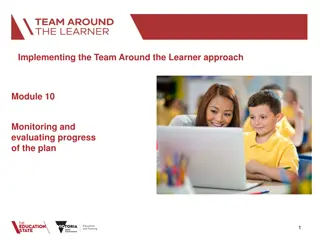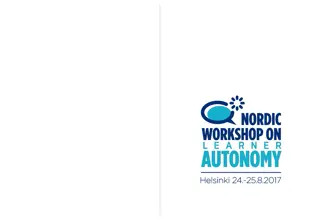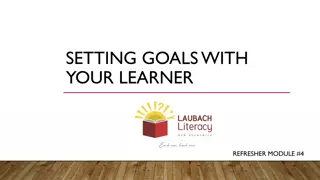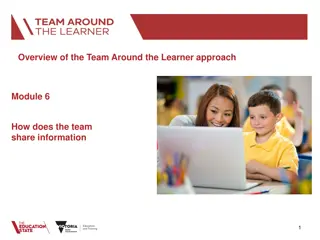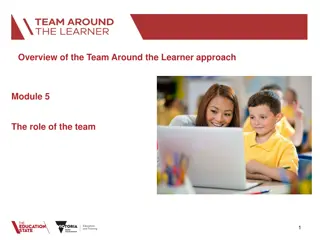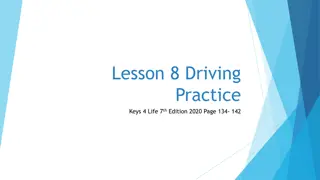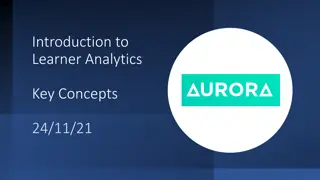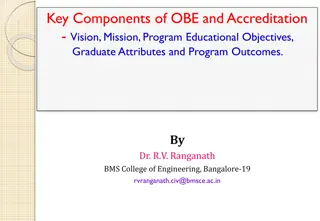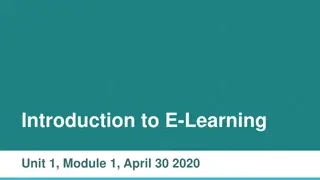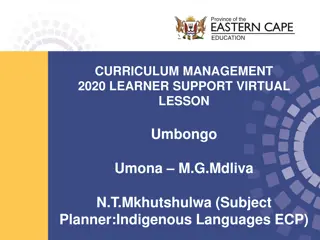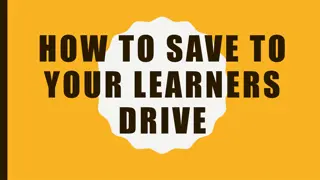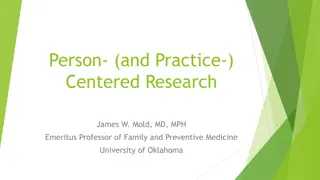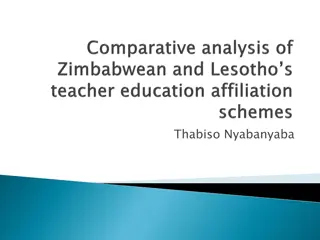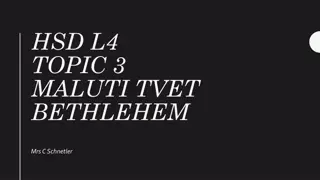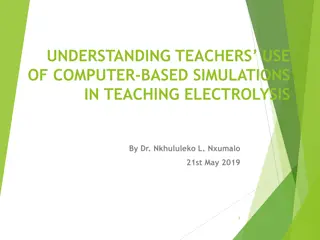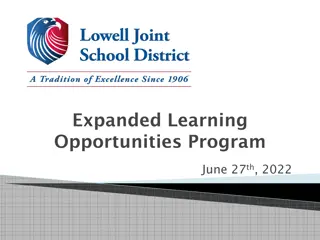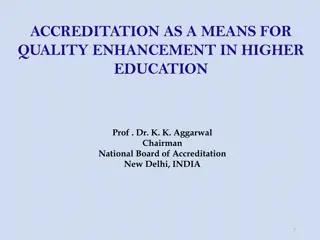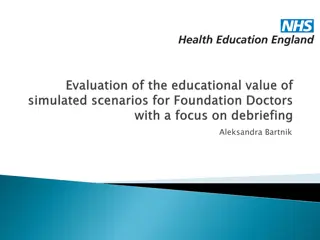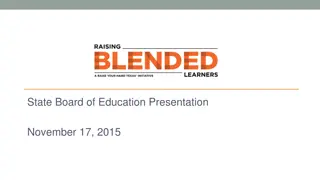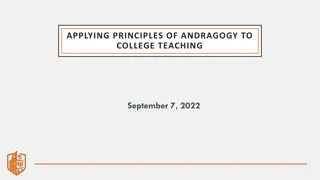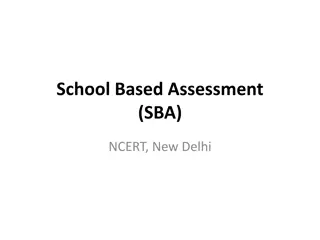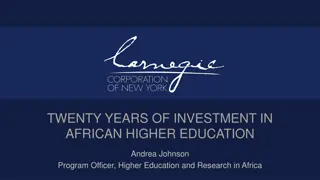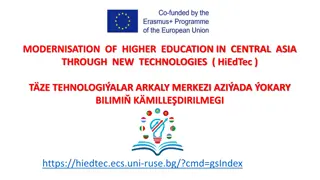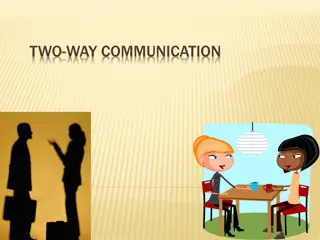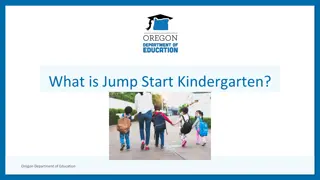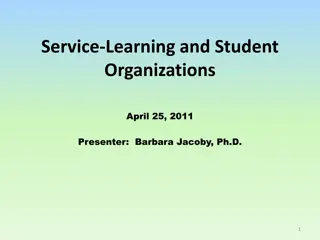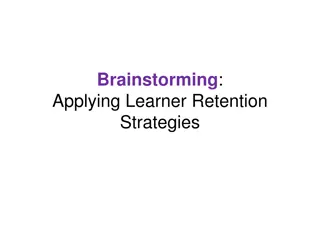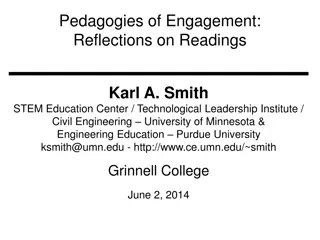Enhancing E-Learning in Higher Education: Quality and Learner-Centered Approach
Explore the theory, practices, and insights on developing high-quality, learner-centered e-learning in higher education. Discover how to support quality learning online, evolve e-learning practices, and adapt to changes post-pandemic. Learn about transitioning to deep-based learning, promoting student responsibility, and providing equal, flexible learning opportunities. Understand the importance of learner-centeredness and student-focused approaches in academic settings.
Download Presentation

Please find below an Image/Link to download the presentation.
The content on the website is provided AS IS for your information and personal use only. It may not be sold, licensed, or shared on other websites without obtaining consent from the author. Download presentation by click this link. If you encounter any issues during the download, it is possible that the publisher has removed the file from their server.
E N D
Presentation Transcript
How to carry out high quality and learner-centered e-learning in Higher Education? Theory, practices and insights on online learning and its development UNI-TEL Study Visit 13.4.2022 Heli Brander, University of Turku
The agenda of the lecture In the context of Higher Education What brings quality to learning? What does learner-centeredness mean? How can quality learning and learner-centeredness be supported online? How has e-learning evolved? What has been learnt during the pandemic? High quality e-learning development where to start?
What brings quality to learning? What is learning ? Learner focused action and functions An individual process in which the learner constructs his or her knowledge through former views and experiences Learner s active interaction with the subject matter Occurring in social context, in interaction with other people
What brings quality to learning? What is quality ? Meeting of the desired and expected standards and the set goals Carrying out appropriate operations and high-quality results Corresponds to the values and features that are considered important from some perspective, for example in learning, we could look at quality by looking at characteristics that are valuable and important from the perspective of the training provider and the learner.
What brings quality to learning? Transition from surface-oriented to deep-based learning by supporting learner's active role, purposefulness and utilization of prior knowledge Supporting student s responsibility on his/her own learning Supporting versatile social interaction Providing individual and flexible learning paths Providing learning that is equal and accessible to all Providing opportunity to study independent of time and place Providing opportunity to develop future working life skills
What does learner-centeredness mean? University of Helsinki: A student-centered approach takes into account individual needs, backgrounds and perspectives, while ensuring that everyone is treated fairly and equally. Students are provided with sufficient services and opportunities to study. Students are responsible for their learning, and they are supported and heard as active parties in their own learning process. Students contribute to University operations and development as members of the University community. South-Eastern Finland University of Applied Sciences: Student-centricity refers to a perspective where the student is at the center of the learning process and the teaching takes into account the students' different basic knowledge, interests and needs, as well as different learning styles. The student is committed to developing their own skills.
Principles of learner-centeredness are included in the current concept of learning Activating learning is more important than teaching Orientation from content design to design of learner s path and learning process Learning can best be promoted by supporting the learner's experiential, interactive and communal knowledge building process Learners are individuals and motivated by different things -> providing flexibility and different methods to reach the objectives is learner-centeredness
How can quality learning and learner- centeredness be supported online? In e-learning, the pedagogical principles of learning themselves remain the same -> how can we support them in online environment? There are a lot of new opportunities but utilizing them is situation- and institution specific Challenges may be posed by the resources and support available, the teachers technical skills and the ability to choose appropriate tools and pedagogical models. In addition, e-learning platforms and tools are constantly evolving and changing and it requires continuous learning.
How can quality learning and learner- centeredness be supported online? The role of an online teacher Builder and developer of a learning environment Expert of the learning content and process Enabler, activator and supporter of learning Instructor and adviser
1) Defining the target group, objectives, and learning contents 2) Planning of the learning process Providing a brief verbal course description 6. Planning of the course s instructive materials (Instructions, study guide etc.) Process of course design 3. Planning of the course s pedagogical learning model, methods and periodization 5. Planning of students support, evaluation and feedback 4. Planning of students activation (learning assignments and tasks) ( Traditional course design process of Brahea Centre at the University of Turku)
How can quality learning and learner- centeredness be supported online? The role of an online teacher at the level of learning activities Planning Setting of the rules Providing instructions and evaluation criteria Providing support and feedback during the process Encouraging and supporting interaction and community building
Elements of support needed in quality e-learning TECHNICAL PEDAGOGICAL Guidance on the use of learning resources Choosing of the learning objectives, contents, methods, and tasks SOCIAL Supporting the learning community Technical support Promoting interaction MENTAL CONTENT Presence Directing learning towards learning objectives Activating students Encouragement Inspiration Providing feedback on content Motivation
Teachers vary in how they succeed in their role as an online teacher Advanced technology users Basic technology users Technical-pedagogical experts Striving for diverse and conscious use of technology, experimentation, and learner-centered work Information technology is used, but not in very diverse ways Smooth and versatile use of various digital materials, different applications and learning environments Gaps in technical skills may cause problems Good technical skills Good technical skills Pedagogical practices are under development, but may not yet be internalized. Deep pedagogical understanding of what digital technology is used for and how it best supports advanced learning practices Students are traditionally passive, as pedagogical practices are based on views of communicating information rather than actively engaging students in the learning process. (Ilom ki 2012)
How have e-learning trends evolved? Versatile activities using e.g. Videos Gamification VR/AR Learning Analytics & AI Mobile Learning Micro Learning STEAM and Maker Culture etc. Rich open source tools and applications Use of social media services Creation and sharing of users' own materials Learning process and learner- centered tools and resources Early LMS s and course tools with e.g. discussion forums and wikis Transferring materials online as such Suominen & Nurmela 2011; P nk 2021 (original source: 2021 Educause Horizon report 2021)
What has been learnt during the pandemic? 2020 Covid-19 forced the whole world to go online overnight New types of flexible pedagogical models were forcibly created by educational institutions -> the term "hybrid teaching" was stabilized to mean a variety of contact and online teaching all over the world Problems arose when trying to transfer traditional teaching practices to the network as such Perceived effects on learners e.g.: Lack of motivation, loneliness, exhaustion, poor quality of teaching/support/materials, dropouts The pandemic has created a whole new era of e-learning -> As skills and experiences have accumulated, so have the expectations and standards of learners P nk 2021 (original source: 20 reports of e-learning trends 2021)
High quality e-learning development where to start? Plan digital tools and the whole learning process based on how they support deep learning and understanding of the content Make technology and learning method choices based on pedagogical solutions - not the other way around. Consider different pedagogical methods and models to support both the individual learning and students interaction Utilize in planning the latest pedagogical research data and best practices on e-learning in your field. Seek answer to the question what motivates the students and what kind of learning solutions would best support their learning and interaction (L fstr m, Kanerva, Tuuttila, Lehtinen & Nevgi 2010)
Sources Educause: 2021 EDUCAUSE Horizon Report: Teaching and Learning Edition. At: https://library.educause.edu/- /media/files/library/2021/4/2021hrteachinglearning.pdf?la=en&hash=C9DEC12398593F297CC634409DFF4B8C5A60B36E Finnish Ministry of Education and Culture: Higher education and research for the 2030s VISION ROADMAP (translation). At: https://okm.fi/documents/1410845/12021888/Korkeakoulutus+ja+tutkimus+2030- luvulle+VISION+TIEKARTTA_V2.pdf/43792c1e-602a-4776-c3f9-91dd66ba9574/Korkeakoulutus+ja+tutkimus+2030- luvulle+VISION+TIEKARTTA_V2.pdf?t=1548923455000 Haapsalo, M. & Er mies, S. University of Jyv skyl : Different Concepts of Learning. At: https://peda.net/jyu/okl/ko/ktkp010- biologia/eo Ilom ki, L. (ed.) 2012: Quality for e-learning materials. E-learning materials in teaching and learning. (translation) Kannisto, T. 2020: The complex quality of learning - how should the quality of learning be assessed? (translation). At: https://blogs.helsinki.fi/digi-phil/2020/12/21/oppimisen-monitahoinen-laatu-kuinka-oppimisen-laatua-tulisi-arvioida/ L fstr m, E., Kanerva,K., Tuuttila, L., Lehtinen, A. & Nevgi, A. University of Helsinki 2010: Quality Online - e-learning handbook for a University teacher (translation) P nk , H.: Trends in technology and social media 2021: The world changed - how does teaching react? (translation) At: https://www.slideshare.net/hponka/teknologian-ja-somen-trendit-2021 Salminen, S. 2014; Aalto University: What is quality? Can we define it? (translation). At: https://www.aaltoee.fi/aalto-leaders- insight/2014/mita-laatu-on-osaammeko-maaritella-sen Suominen, R. & Nurmela, S. 2011: Online teacher.


